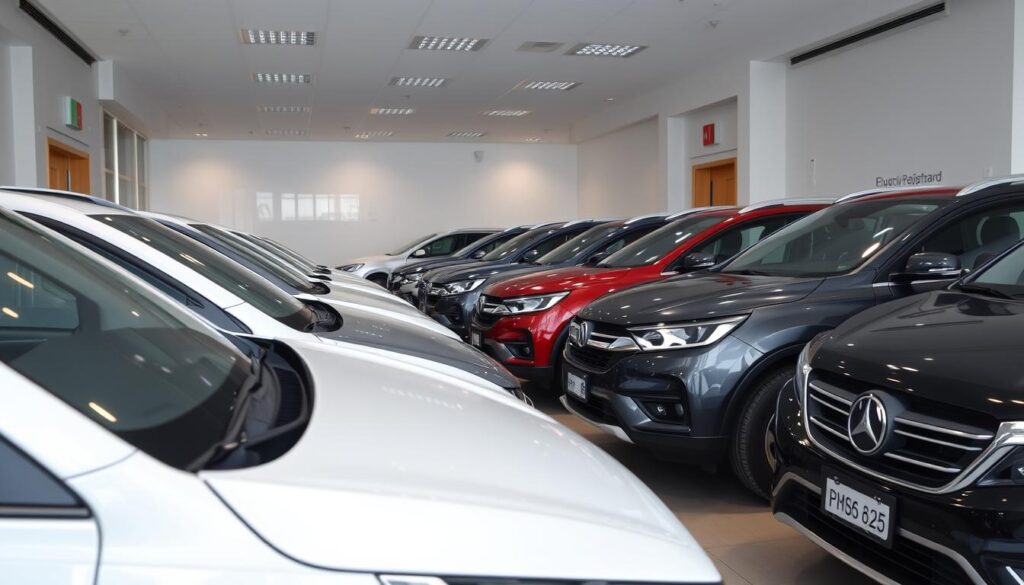Curious whether moving a vehicle across the border can be simple, predictable, and budget friendly? This guide answers that question with clear steps and realistic numbers.
Expect straightforward advice: average cross-border transport quotes often range from $1,000 to $2,500, with shorter routes sometimes near $800–$1,000. Typical transit time is 10–14 days, and about 85% of moves use truck carriers.
Readers will learn each step of the process. That includes eligibility checks, U.S. export paperwork, the Canada Border Services Agency requirements, and the RIV inspection timeline.
Practical cost items are listed clearly — GST, provincial PST/HST, possible 6.1% duty on non‑North‑American builds, and the RIV fee of about CAD 325 plus tax.
The section also explains carrier choices, insurance basics, and why choosing an experienced company matters for risk management and on‑time delivery.
Key Takeaways
- Expect 10–14 days transit and typical truck transport for most moves.
- Budget for transport charges plus GST, provincial tax, and possible 6.1% duty.
- Prepare U.S. export docs in advance and complete the RIV inspection within 45 days.
- Choose a company with cross‑border experience and clear insurance and condition reports.
- Planning costs and timeline avoids surprises at delivery in car canada.
Before You Start: Eligibility, Regulations, and What “Importing” Really Means

Confirm eligibility first — that single step avoids costly surprises later. Start by checking the Registrar of Imported Vehicles compatibility list. Transport Canada publishes the list from manufacturer data, but accuracy can change without notice.
The list is a starting point. Some models shown as eligible still require expensive modifications. If a vehicle cannot meet Canadian standards, it cannot remain and must be exported.
Registrar of Imported Vehicles compatibility list and vehicle eligibility
Modified and multi-stage manufactured vehicles often face extra rules. Examples include raised-roof vans, stretched limousines, and vocational trucks. These vehicles may need extra paperwork or simply fail eligibility.
Visitor or temporary resident vs. permanent import
Visitors, students, and temporary workers may bring personal vehicles for limited stays. Permanent imports follow the formal import process and must clear export at the U.S. side, pay duties and taxes at the border, and pass the RIV inspection within 45 days (one year for salvage).
“Unresolved recalls or failed inspections will prevent registration and can force export.”
- Check the RIV list for make, model, and year before purchase.
- Confirm recall clearance; unresolved recalls block the process.
- Get written estimates for any required modifications in advance.
How to ship a car from usa to canada: A step-by-step process

Start with a clear checklist that maps each required step. Confirm RIV eligibility and get a manufacturer recall clearance. This prevents delays at registration and reduces risk at the border.
Key operational steps
Choose a shipping method and pick a company with cross‑border experience. Open carriers lower cost; enclosed carriers add protection for high‑value cars. Agree on pickup windows and a single point of contact.
Engage a customs broker early to secure the ITN (fees around $200). Submit title and ITN to the U.S. CBP export office at least 72 hours before crossing.
At the border, present ID, title, bill of sale, recall letter, and complete Form 1. Pay assessed tax and any duty. Forward the stamped Form 1 immediately to RIV.
Inspection and registration
Schedule the RIV inspection within 45 days. Complete required modifications such as daytime running lights or a km/h speedometer. After passing, register the vehicle in the destination province.
| Method | Typical cost | Protection / time |
|---|---|---|
| Open carrier | $800–$1,500 | Lower cost / 10–14 days |
| Enclosed carrier | $1,200–$2,500 | High protection / similar time |
| Door‑to‑door service | Varies; add broker fees | Convenience / aligns paperwork |
Duties, Taxes, and Fees: What you must pay at the border and beyond
Understanding fees at the border is essential for accurate budgeting and no-surprise delivery.
USMCA can waive duties for qualifying North American builds. If the vehicle fails that test, expect a 6.1% import duty based on declared value.
All imports owe 5% GST. Provincial sales tax or HST is added at registration and varies by province. The RIV fee is about CAD 325 plus tax. An air conditioning excise of roughly $100 applies when fitted.
- Confirm USMCA eligibility before crossing; otherwise plan for the 6.1% duty.
- Include ITN procurement (~$200) and common customs clearance fees (~$355).
- Budget for variable surcharges such as excess weight or fuel-efficiency penalties.
| Item | Typical amount | When paid |
|---|---|---|
| Import duty (non-NA) | 6.1% of value | At border assessment |
| GST | 5% of value | At payment/registration |
| RIV fee + tax | CAD 325+ | After Form 1 / RIV submission |
| ITN & customs | $200 + ~$355 | Pre-crossing / clearance |
Combine transport cost, duties, and provincial levies to calculate landed cost for standard vehicle, SUV, or luxury models. Choose a company that provides a clear service quote and itemized costs for easy reconciliation after delivery in imported canada.
Meeting Canadian Standards: Recalls, modifications, and the RIV inspection
Meeting Canada’s safety checks is the critical step that decides whether a vehicle clears import rules. The Registrar of Imported Vehicles maintains a compatibility list, but that list changes and does not guarantee approval.
Recall clearance documentation: why it’s mandatory
Secure a manufacturer recall clearance letter before transport. Without that letter the RIV will not continue the inspection or approve registration.
Common modifications and compliance
Most imported cars require simple fixes. Typical upgrades include daytime running lights and a primary speedometer that reads in km/h.
Inspection timelines, failures, and export requirement
Schedule an RIV inspection within 45 days (one year for salvage). Plan any shop work ahead of that time to avoid missed appointments.
A failed inspection has strict consequences. If a vehicle fails, it cannot remain in the country even after tax and duty are paid. Modified builds like motorhome conversions or lifted trucks often do not qualify.
“Unresolved recalls or failed inspections will prevent registration and can force export.”
- Keep recall letter, Form 1, and later Form 2 available at the inspection site.
- Confirm parts and compliance options for your model year before purchase.
- Use a transport partner that can deliver directly to the inspection facility to save time and reduce risks.
Logistics and Transport: Methods, routes, insurance, and timing
Logistics decisions shape cost, timing, and risk for every interstate vehicle move. Most cross‑border transports move by truck and average 10–14 days transit. Choosing the right carrier and route reduces delays and protects value.
Open carrier vs. enclosed carrier
Open carriers are the most cost‑effective for everyday cars and SUVs. They offer reliable transit windows at lower cost.
Enclosed carriers suit luxury, collector, or low‑clearance vehicles that need extra protection. Expect higher rates and similar transit time.
Popular lanes and typical transit durations
Major lanes include Arizona–Saskatchewan, Texas–Edmonton, and Massachusetts–Winnipeg. Most lanes follow the 10–14 day norm, though mountain corridors and long distances can extend time.
Insurance coverage during transport
Professional carriers provide in‑transit insurance and condition reports. Confirm coverage limits, deductibles, and exclusions. Request the certificate and ensure the vehicle is listed on the bill of lading.
- Obtain pickup and delivery photos for claims support.
- Keep fuel at ~25% and remove personal items to meet insurance rules.
- Choose door‑to‑door for convenience or terminal pickup for lower cost.
Seasonality and timing
Summer demand and winter storms affect capacity and price. Book early for peak months and align delivery with the RIV inspection window to avoid storage fees.
Contact for transport service and questions: BestCarShippingInc at (307) 288-5972 or info@bestcarshippinginc.com.
Documentation and Border Procedure: Paperwork checklist and forms
Accurate documentation is the single best defense against clearance holdups at the border. A correct set of papers speeds processing and lowers the risk of re-dispatch or storage fees.
Core documents you must carry
Prepare the original vehicle title, the bill of sale, valid government ID, and a manufacturer recall clearance letter. Keep both printed and digital copies.
Form 1 and Form 2: the chain that enables inspection
Print the RIV Vehicle Import E-form (Form 1) and hand it to CBSA at crossing. Once CBSA stamps Form 1, submit it to the registrar to receive Form 2 for the inspection appointment.
Coordinating export and using a broker
File the title and ITN with the U.S. CBP export office before crossing. A customs broker commonly handles ITN filing, confirms document formats, and tracks clearance to avoid queues.
- Match names and VINs across every document.
- Clarify who must be present at the border based on your logistics plan.
- Request written confirmation from your broker when entries are filed.
“Keep copies of all documents—digital and paper—for redundancy; border agents may ask for duplicate proof if systems are down.”
Need assistance? Contact BestCarShippingInc at (307) 288-5972 or info@bestcarshippinginc.com for broker referrals and checklist review.
Cost Factors and Planning: Distance, vehicle type, and shipping service
Budget planning begins with the route and the vehicle profile—those two items shape most final quotes. Distance drives fuel and driver time. Remote lanes or detours add linehaul charges and time.
Distance and route complexity
Longer corridors raise basic transport charges and increase potential delays. Mountain crossings or congested border posts can extend transit beyond the usual 10–14 days.
Vehicle size, weight, and specialty models
Oversize or heavy models need special spots and may incur accessorial fees. Enclosed service, expedited pickup, and door‑to‑door delivery add premiums but cut coordination time.
| Factor | Impact | Typical effect on price |
|---|---|---|
| Distance & route | Fuel, driver hours, transit time | Low–High ($800–$2,500) |
| Vehicle size/type | Space, secure handling, special equipment | +10%–40% for oversized SUVs/trucks |
| Service level & season | Enclosed, door delivery, peak demand | +15%–50% depending on options |
| Customs & tax | Duty, GST/HST, broker fees | ~20% of combined project budget |
Plan ahead: ask the company for an itemized quote that lists linehaul, fuel surcharge, insurance, accessorials, and tax estimates. Keep paperwork current and retain receipts for swift clearance and registration.
“Itemized quotes remove surprises and protect value in cross-border projects.”
Questions or ready for a quote? Contact BestCarShippingInc at (307) 288-5972 or info@bestcarshippinginc.com.
Conclusion
,
Concluding guidance highlights the essential documents, fees, and timelines that determine a smooth import.
Plan eligibility first. Confirm registrar imported status and secure recall clearance. File the ITN and present Form 1 at customs before arrival.
Budget for duties and taxes. USMCA may waive duty for North American builds; non‑NA vehicles often face a 6.1% duty. GST and provincial PST/HST must pay at registration.
Work with a broker and an experienced carrier. They handle timing, insurance, and delivery in the typical 10–14 day window and help meet canadian standards for inspection.
Need help? Contact Best Car Shipping Inc. at (307) 288-5972 or info@bestcarshippinginc.com for service and planning in imported canada and vehicle canada.
